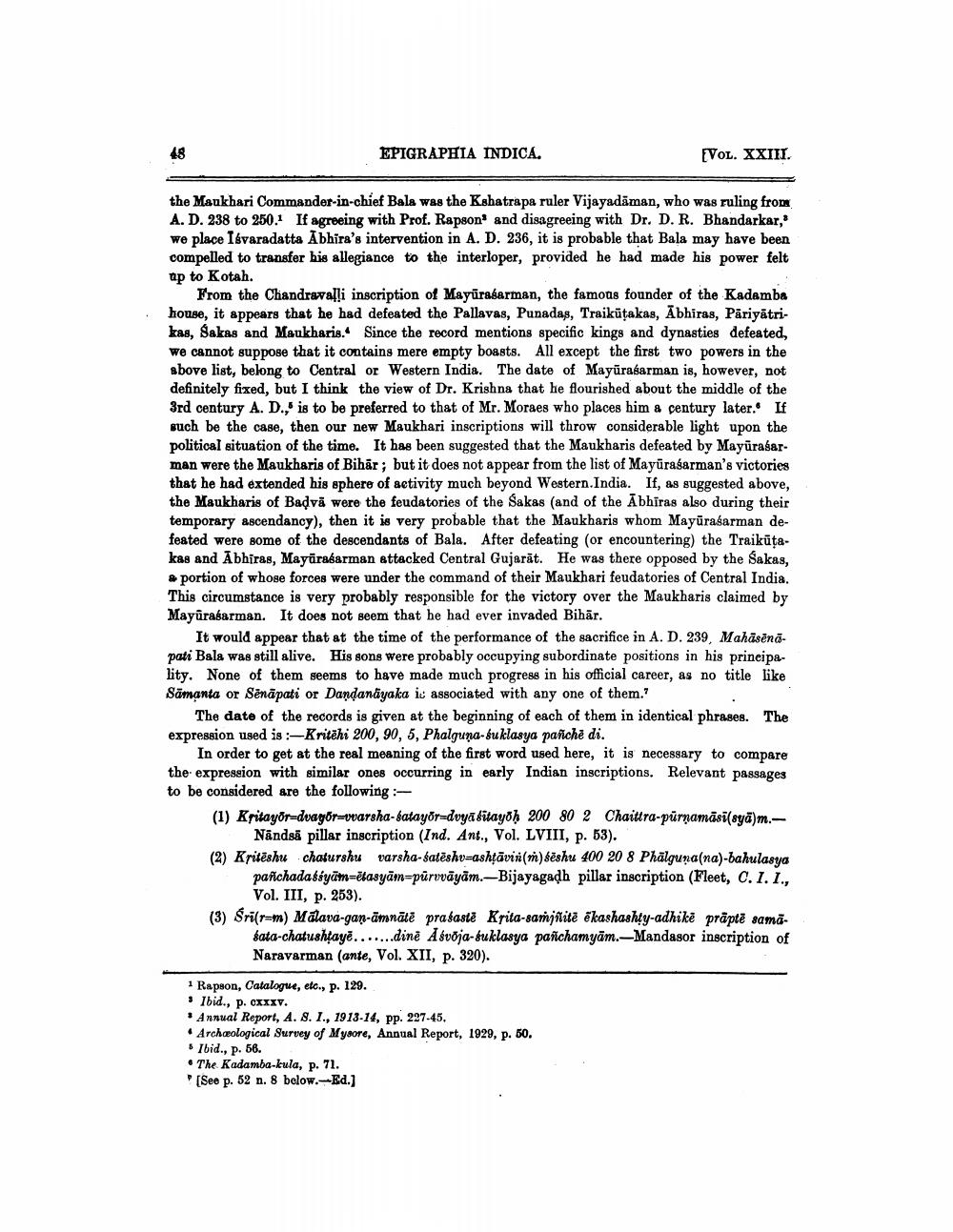________________
EPIGRAPHIA INDICA.
VOL. XXIII.
the Maukhari Commander-in-chief Bala was the Kshatrapa ruler Vijayadāman, who was ruling from A. D. 238 to 250.1 If agreeing with Prof. Rapson and disagreeing with Dr. D. R. Bhandarkar, we place Isvaradatta Abhira's intervention in A. D. 236, it is probable that Bala may have been compelled to transfer his allegiance to the interloper, provided he had made his power felt ap to Kotah.
From the Chandravalli inscription of Mayūrasarman, the famous founder of the Kadamba house, it appears that he had defeated the Pallavas, Punadas, Traikutakas, Abhiras, Päriyātrikas, Sakas and Maukharis. Since the record mentions specific kings and dynasties defeated, we cannot suppose that it contains mere empty boasts. All except the first two powers in the above list, belong to Central or Western India. The date of Mayūrafarman is, however, not definitely fixed, but I think the view of Dr. Krishna that he flourished about the middle of the 3rd century A. D., is to be preferred to that of Mr. Moraes who places him a century later. If such be the case, then our new Maukhari inscriptions will throw considerable light upon the political situation of the time. It has been suggested that the Maukharis defeated by Mayūrasarman were the Maukharis of Bihār; but it does not appear from the list of Mayūrasarman's victories that he had extended his sphere of activity much beyond Western. India. If, as suggested above, the Maukharis of Badvă were the feudatories of the Sakas (and of the Abhiras also during their temporary &scendancy), then it is very probable that the Maukharis whom Mayūraśarman defeated were some of the descendants of Bala. After defeating (or encountering) the Traikūtakas and Abhiras, Mayārabarman attacked Central Gujarāt. He was there opposed by the Sakas, & portion of whose forces were under the command of their Maukhari feudatories of Central India. This circumstance is very probably responsible for the victory over the Maukharis claimed by Mayūraśarman. It does not seem that he had ever invaded Bihār.
It would appear that at the time of the performance of the sacrifice in A. D. 239, Mahäsēnēpati Bala was still alive. His sons were probably occupying subordinate positions in his principality. None of them seems to have made much progress in his official career, as no title like Sämanta or Sēnāpati or Dandanāyaka is associated with any one of them.?
The date of the records is given at the beginning of each of them in identical phrases. The expression used is :- Kritēhi 200, 90, 5, Phalguna-su klasya pañche di.
In order to get at the real meaning of the first word used here, it is necessary to compare the expression with similar ones occurring in early Indian inscriptions. Relevant passages to be considered are the following - (1) Kritayor-dvayor=varsha-latayőr-dvya sitayoh 200 80 2 Chaittra-purnamāsi(syā)m.
Nāndsä pillar inscription (Ind. Ant., Vol. LVIII, p. 53). (2) Kritēshu chaturshu varsha-satēshv=ashtāvini () dëshu 400 20 8 Phälguna(na)-bahulasya
panchadassyūm=ētasyām=pūrvvāyām.Bijayagadh pillar inscription (Fleet, C.1.1.,
Vol. III, p. 253). (3) Sril-m) Malava-gan-amnāte pra faste krita-samjfitë ēkashashty-adhikė präptē sama
sata-chatushaye.......dine A svoja-buklasya pañchamyām.-Mandasor inscription of Naravarman (ante, Vol. XII, p. 320).
1 Rapson, Catalogue, etc., p. 129. • Ibid., p. CXXXV. . Annual Report, A. 8. I., 1913-14, pp. 227-45. • Archæological Survey of Mysore, Annual Report, 1929, p. 50. * Ibid., p. 56. • The Kadamba-kula, p. 71. (See p. 52 n. 8 below.Ed.)




